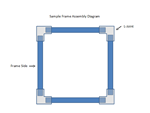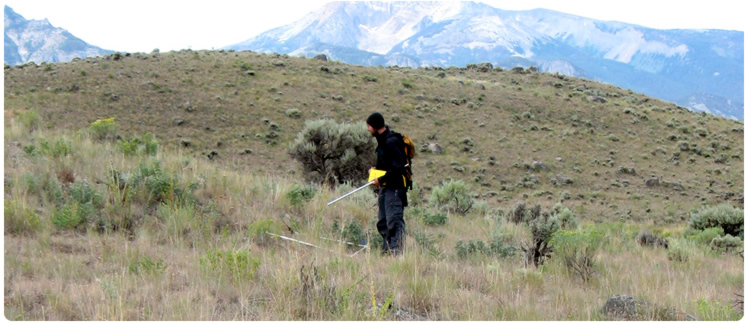Evaluating NIS Management Success
Evaluating the Effectiveness of Control/Management
This type of evaluation allows you to determine if the abundance or area of target
NIS has been reduced by your management practices. In order to determine if your NIS
management is having the desired effect, and if this, in turn, is meeting your land
management goals, you must record NIS abundance before management, and then re-visit
NIS management sites again after management has been applied. You must also have un-managed
plots and perform the same measurements on them - as plant abundance or area varies
between years (often due to climate), and you don't want to be treating populations
that were going away anyway. Initially, management should be tested on a small scale
(i.e., a small section of the management area) to avoid spending unnecessary time
and money applying ineffective management to your entire management area.
As with invasiveness, management effectiveness may vary for different levels of PO.
For this reason, we recommend that you stratify your evaluation of control measures
in a similar way to how you stratify a monitoring plan for monitoring invasiveness. The process is the same as monitoring for invasiveness, except that management will
be applied after the initial monitoring session (i.e., between years one and two)
There are three main ways in which management effectiveness can be evaluated. The methods described below must be completed before and after management, AND on un-managed plots (using the same methods) to evaluate if management is effective!
1. Record the perimeter of NIS populations with a GPS.

2. Record stem density or % cover of the NIS in plots within populations.

3. Photo Monitoring

*The procedures above should be completed at a time when the NIS is easily identified and seasonal growth has reached its maximum. And, at the same time each year.
Comparing ‘before management’ and ‘after management’ documentation of abundance, as
well as the un-managed plots, allows you to evaluate if management has been effective.
If your management has not reduced the abundance of the target NIS, or does not differ
from the un-managed plots, you should try a different approach. Also, be aware of
the potential off target impacts that management may have. Learn more about Off Target
Impacts![]()

Once an NIS management plan is enacted across the entire management area (i.e. at the large scale) this type of evaluation should be conducted regularly (i.e. every 1-3 seasons), and records of the results of management should be maintained in such a way that they could be read and interpreted by someone unfamiliar with the management area, the land and NIS management goals, and even the NIS being targeted for management. A list of information that you should record for each NIS you are managing is given below. It is not necessary to visit each population you treated. We recommend using a PO risk map to select representative populations in low, medium and high risk categories. These sub-samples will provide an idea of how populations in similar areas are responding to management.
Geographic Location of All Populations
Record the geographic location (center point) of populations that you are managing in each management area. This should be done with GPS if available, but population locations can also be approximated by hand on a map if necessary.
Geographic Location and ID of Monitoring Populations
If you are managing a very large number of populations, select a sub-set of these to monitor. Use your PO map to select multiple populations in low, medium, and high PO areas. Select an equal number of populations in each PO category if possible. Make sure to keep track of the geographic locations and population ID’s of your monitoring populations.
NIS Management Objective
Remember to be specific! For example write “Decrease spotted knapweed cover by 50%
within 2 years” or “Reduce the infested area by 20% within 5 years”, instead of “reduce
knapweed cover”.
Pre-Management NIS Abundance and/or Area. In order to determine if management was
effective, you must record the pre-management attributes of NIS as described above.
This is where information for un-managed plots would also be maintained – so that
you can continue to assess if your management approach is better than doing nothing
or, for which parts of the landscape and PO gradient that may be true.
Management History. Record the management information for the area each year even
if you don’t sample each year. Collect GPS data for each management event if you can.
When was the management applied? What specifically was used and, if applicable what
rate of herbicide was used? For example, an entry for management history might look
like this:
Initial Treatment, 5-31-07, sheep grazing (20 sheep, penned in 150ftx150ft enclosure,
rotated every 5 days)
Current NIS Abundance and/or Area
Use exactly the same method you used to estimate pre-management NIS attributes at the same time of year. The same is true of your un-managed plots. This is essential to determine if you have met your NIS management objectives.
NIS Management Success
Use the NIS monitoring data (i.e. the pre and current abundance and area data from managed and un-managed plots) you collected to assess whether or not your current management strategy is helping you meet your NIS management objectives. If it is not, determine how you might be able to change your NIS management to better meet your objectives.
Land Management Success
Remember that NIS management is usually enacted in order to help meet some broader land management goals. Therefore, you must ensure that NIS management is not interfering with these goals. If you are not the primary stakeholder, make sure that you are given a clear list of land management goals so that you can determine if your NIS management strategy is compatible with those goals.

